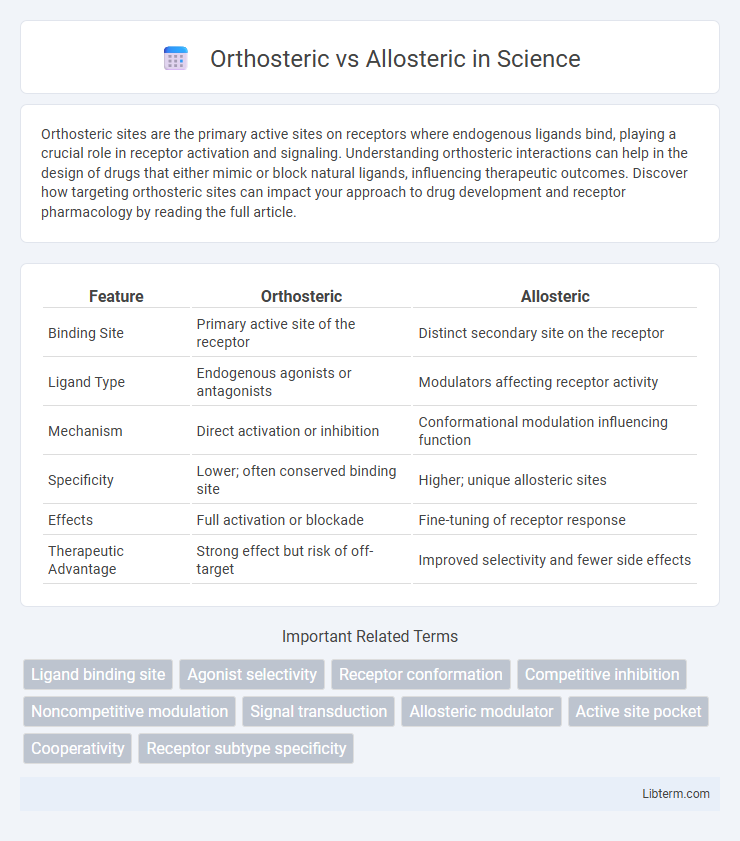Orthosteric sites are the primary active sites on receptors where endogenous ligands bind, playing a crucial role in receptor activation and signaling. Understanding orthosteric interactions can help in the design of drugs that either mimic or block natural ligands, influencing therapeutic outcomes. Discover how targeting orthosteric sites can impact your approach to drug development and receptor pharmacology by reading the full article.
Table of Comparison
| Feature | Orthosteric | Allosteric |
|---|---|---|
| Binding Site | Primary active site of the receptor | Distinct secondary site on the receptor |
| Ligand Type | Endogenous agonists or antagonists | Modulators affecting receptor activity |
| Mechanism | Direct activation or inhibition | Conformational modulation influencing function |
| Specificity | Lower; often conserved binding site | Higher; unique allosteric sites |
| Effects | Full activation or blockade | Fine-tuning of receptor response |
| Therapeutic Advantage | Strong effect but risk of off-target | Improved selectivity and fewer side effects |
Introduction to Orthosteric and Allosteric Regulation
Orthosteric regulation involves the direct binding of a ligand to the primary active site of a receptor or enzyme, leading to a conformational change that modulates biological activity. Allosteric regulation occurs when molecules bind to distinct sites separate from the orthosteric site, inducing conformational changes that either enhance or inhibit the receptor's function. These mechanisms provide diverse therapeutic targets by offering specificity and fine-tuning of receptor activity in drug design.
Defining Orthosteric Binding Sites
Orthosteric binding sites are specific regions on receptors where endogenous ligands, such as neurotransmitters or hormones, directly interact to activate or inhibit receptor function. These sites are highly conserved and crucial for receptor specificity, enabling precise molecular recognition and signal transduction. Understanding orthosteric binding contrasts with allosteric sites, which modulate receptor activity indirectly by binding to alternative locations.
Understanding Allosteric Binding Sites
Allosteric binding sites are distinct regions on a protein, separate from the orthosteric site where endogenous ligands bind, allowing modulators to influence receptor activity without directly competing with natural substrates. These sites enable fine-tuning of receptor function through conformational changes, offering increased specificity and reduced side effects in drug design. Understanding allosteric binding mechanisms facilitates the development of targeted therapies that can enhance or inhibit receptor responses with greater precision compared to orthosteric agents.
Molecular Mechanisms of Orthosteric Modulation
Orthosteric modulation occurs when ligands bind directly to the active site of a receptor, competing with endogenous substrates and causing conformational changes that trigger a cellular response. This binding typically involves specific interactions with amino acid residues within the orthosteric site, influencing receptor activation or inhibition based on ligand affinity and efficacy. Molecularly, orthosteric modulators alter receptor dynamics by stabilizing active or inactive conformations, fundamentally regulating signal transduction pathways.
Mechanisms of Allosteric Modulation
Allosteric modulation occurs when a ligand binds to a site on a receptor distinct from the orthosteric site, inducing conformational changes that alter receptor activity. This mechanism enables fine-tuning of receptor responses by enhancing or inhibiting the effect of the orthosteric ligand without directly competing for the primary binding site. Such modulation offers therapeutic advantages by providing greater selectivity and reducing side effects compared to orthosteric targeting.
Functional Differences: Orthosteric vs Allosteric Effects
Orthosteric ligands bind directly to the active site of a receptor, competitively modulating its primary function by either activating or inhibiting the receptor's biological response. Allosteric ligands bind to distinct sites separate from the active site, inducing conformational changes that modulate receptor activity by enhancing or diminishing the effects of orthosteric ligands without directly activating the receptor themselves. Functional differences include orthosteric effects being typically binary (agonist or antagonist), while allosteric effects offer nuanced regulation, such as positive or negative modulation, allowing more precise control of receptor signaling pathways.
Therapeutic Potential of Orthosteric Compounds
Orthosteric compounds bind directly to the active site of target receptors, providing precise modulation of receptor activity essential for therapeutic efficacy. These compounds often demonstrate high potency and specificity, enabling effective treatment of diseases by directly influencing endogenous ligand binding. The therapeutic potential of orthosteric drugs is highlighted by their widespread use in conditions such as hypertension, asthma, and neurological disorders, where targeted receptor activation or inhibition is critical.
Advantages of Allosteric Modulators in Drug Design
Allosteric modulators offer increased receptor subtype selectivity by binding to sites distinct from the orthosteric ligand-binding domain, reducing off-target effects and enhancing drug safety profiles. They enable fine-tuning of receptor activity, allowing for partial agonism or antagonism, which preserves physiological signaling and minimizes desensitization or receptor downregulation. Their capacity to modulate receptor function in a context-dependent manner supports the development of drugs with improved efficacy and reduced adverse effects in complex disease states.
Challenges in Targeting Orthosteric and Allosteric Sites
Targeting orthosteric sites faces challenges such as high competition with endogenous ligands and limited selectivity due to conserved binding pockets across receptor subtypes. Allosteric sites pose difficulties in identifying structurally diverse modulators with consistent efficacy and predicting their complex modulatory effects on receptor function. Both approaches require advanced screening techniques and structural biology insights to overcome issues in drug design specificity and therapeutic window optimization.
Future Trends in Orthosteric and Allosteric Research
Future trends in orthosteric and allosteric research emphasize the development of more selective and efficacious drugs targeting G protein-coupled receptors (GPCRs) and ion channels, leveraging advances in structural biology and computational modeling. Emerging technologies such as cryo-electron microscopy and artificial intelligence enable precise mapping of binding sites, enhancing the design of modulators with optimized therapeutic profiles and reduced side effects. Integration of multi-omics data and high-throughput screening methods accelerates the discovery of novel orthosteric and allosteric ligands, driving personalized medicine and innovative treatments for complex diseases.
Orthosteric Infographic

 libterm.com
libterm.com